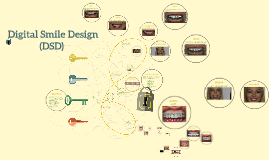Digital Smile Design
Transcript: Dr. Sohaib Q. Khalil DDS in Dentistry, MSc in Prosthodontics Digital Smile Design Digital Planning To Clinical Reality Importance Introduction Introduce your treatment plane and previous work to your patient gaining his trust in a beautiful way. Good communication with your lab that helps a lot to improve your work (Visual communication). The concepts of esthetics and beauty are so intimately related and vary within and between different cultures and ethnic and age groups - Individual preferences - Personal style - Experiences Concepts of Esthetics What can we do to increase the case acceptance? 1. Photos Album. 2. DSD - Mock up - Trial Restoration.......Pt live with smile What can we do to increase the case acceptance? Past We should not focus our evaluation only on the teeth and the treatment plan should not be based on the dentitionز A smile is not only made up of teeth, but rather consists of several elements. Facial esthetics o Evaluate facial height (upper and lower). o Facial midline (90% of the cases the facial midline is coincident with the dental midline, andshiftup to 2mm it is accepted). o Lips. o Width of the smile. Gingival esthetics o Gingival zenith. o Gingival line. o Emergency profile. o Gingival biotype. o Amount of gingival display. Macro esthetics Micro esthetics o Surface characterizations. o Surface glaze. o Labial anatomy. o Tooth colour. o Tooth shape. oDental midline. oTeeth length. oSmile arc. oTooth dimensions. oBuccal corridors. oEsthetic proportions (Golden proportions). but that proportions make unrealistic results as there is no fixed proportions can be done on all people so here come the REDproportions What is digital smile design? What?! Digital Smile Design is a process that uses computer-aided design to create custom-made veneers, custom crowns, and other dental implants. The advantage of this approach is that it allows the dentist to see how the final results will look before any treatment is actually performed Clinicians can have many points to help to solve esthetic issue Mock-up based on digital smile design (DSD) measurements. (A) Diagnostic wax-up using the DSD as a guide. (B) Silicone index for the construction of the mock-up. (C) Removal of excess bis-acrylic resin from the silicone index. (D) Mock-up enabling clinical visualization of the maxillary (from premolar to premolar) and mandibular (from canine to canine) teeth in the frontal view of the patient's smile. DSD Virtual treatment planning with digital smile design (DSD). (A) Full-face photograph with horizontal (bipupillary and intercommissural lines) and vertical (facial midline) reference lines. (B) The design of the dental profile is guided by the facial lines (facial midline and lower lips) and by the relationship of the rectangles. (C) Design showing the proposed changes to the length of tooth no. 12 (lengthen 2.0 mm), no. 21 and no. 22 (lengthen 1.3 mm), and to the width of the central incisors (8.5 mm). (D) Simulation of the smile using Adobe Photoshop software Facial Parameteres Facial Parameters Horizontal Line Reference points: - Interpupillary line - Commissural line Importance Importance? If we notice a cant of the midline (midline is not perpendicular on the H line), we must make sure that the problem is not dental, as the problem may be due to the tilt of the patient's image. We confirm this by drawing the horizontal line and find that it is not compatible with the line passing between the pupils of the eyes Facial assymmetry If there is a defect in one of the horizontal reference lines, we choose the correct one: - Interpupillary line - Commissural line Mid-Line Reference points: - Glabella - Philtrum - Mentum Mid-Line Which one is more or less acceptable? Canted mid-line Canting Any tilt in the midline, even if it is half a degree, is noticeable and unacceptable E-Ricket E-line: One useful element in determining the profile type is an evaluation of the position of the lips with reference to an ideal line that joins the tip of the nose to the tip of the chin. According to rickets in a normal profile the upper lip is about 4 mm posterior to the E-line, while the lower lip is about 2 mm posterior. Dento-Facial Parameters Smile curve In an ideal tooth arrangement, that line should coincide or follow the curvature of the lower lip while smiling. Incisal edge of upper maxillary teeth comes very close to and almost touches upper border of the lower lip. The lower lip, being no more than 2 mm away. How do lips affect smile design? The lip area is critical. Importance Importance? - Anterior aspect of curve determines incisal edge position. - Posterior aspect determines amount of buccal corridor. Reference: - In max smile: the teeth must fill 60 -80% from space between inferior border of upper lip and superior border of lower lip. - Buccal corridor: distance between inner check to buccal surface of last tooth in smile from 2-4 mm. It shouldn’t be eliminated because the negative space imparts a suggestion

















